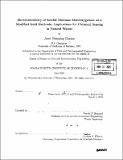| dc.contributor.advisor | Harold F. Hemond. | en_US |
| dc.contributor.author | Chuang, Janet Duanping | en_US |
| dc.contributor.other | Massachusetts Institute of Technology. Dept. of Civil and Environmental Engineering. | en_US |
| dc.date.accessioned | 2006-02-02T18:53:42Z | |
| dc.date.available | 2006-02-02T18:53:42Z | |
| dc.date.copyright | 2005 | en_US |
| dc.date.issued | 2005 | en_US |
| dc.identifier.uri | http://hdl.handle.net/1721.1/31156 | |
| dc.description | Thesis (S.M.)--Massachusetts Institute of Technology, Dept. of Civil and Environmental Engineering, 2005. | en_US |
| dc.description | Includes bibliographical references (p. 87-90). | en_US |
| dc.description.abstract | This work explored the possibility of using the soluble methane monooxygenase (MMO) enzyme, a three-component enzyme which catalyzes the oxygenation of methane and other substrates, to design a methane sensor for use in natural waters. Such a sensor would be useful for monitoring lake biogeochemistry, including the potential for lakes to be a source of methane into the atmosphere. An op amp-based potentiostat was constructed, and a LabVIEW program was written to control the instrument and acquire data digitally. Cyclic voltammetry experiments were conducted with both acetonitrile, a liquid substrate, and the natural substrate methane. With the hydroxylase component of the enzyme (MMOH) adsorbed onto a peptide-modified gold electrode, the amount of charge transferred during a scan depended on both substrate and oxygen concentrations. This concentration dependence did not occur when MMOH was not present. In the case of methane, the kinetic limitations of partitioning between gas and liquid phases may have contributed to experimental scatter. These results raise the possibility that MMOH may be used without the other two components to generate a reproducible, concentration-dependent signal. Signal strength was also dependent on the order in which high- and low-concentration trials were conducted. The hydroxylase may be able to store methane and oxygen in a hydrophobic cavity for later use, an observation that has both ecological and sensor-design implications. | en_US |
| dc.description.statementofresponsibility | by Janet Duanping Chuang. | en_US |
| dc.format.extent | 90 p. | en_US |
| dc.format.extent | 4754623 bytes | |
| dc.format.extent | 4764724 bytes | |
| dc.format.mimetype | application/pdf | |
| dc.format.mimetype | application/pdf | |
| dc.language.iso | eng | en_US |
| dc.publisher | Massachusetts Institute of Technology | en_US |
| dc.rights | M.I.T. theses are protected by copyright. They may be viewed from this source for any purpose, but reproduction or distribution in any format is prohibited without written permission. See provided URL for inquiries about permission. | en_US |
| dc.rights.uri | http://dspace.mit.edu/handle/1721.1/7582 | |
| dc.subject | Civil and Environmental Engineering. | en_US |
| dc.title | Electrochemistry of soluble methane monooxygenase on a modified gold electrode : implications for chemical sensing in natural waters | en_US |
| dc.title.alternative | Electrochemistry of soluble MMO on a modified gold electrode | en_US |
| dc.type | Thesis | en_US |
| dc.description.degree | S.M. | en_US |
| dc.contributor.department | Massachusetts Institute of Technology. Department of Civil and Environmental Engineering | |
| dc.identifier.oclc | 61206731 | en_US |
